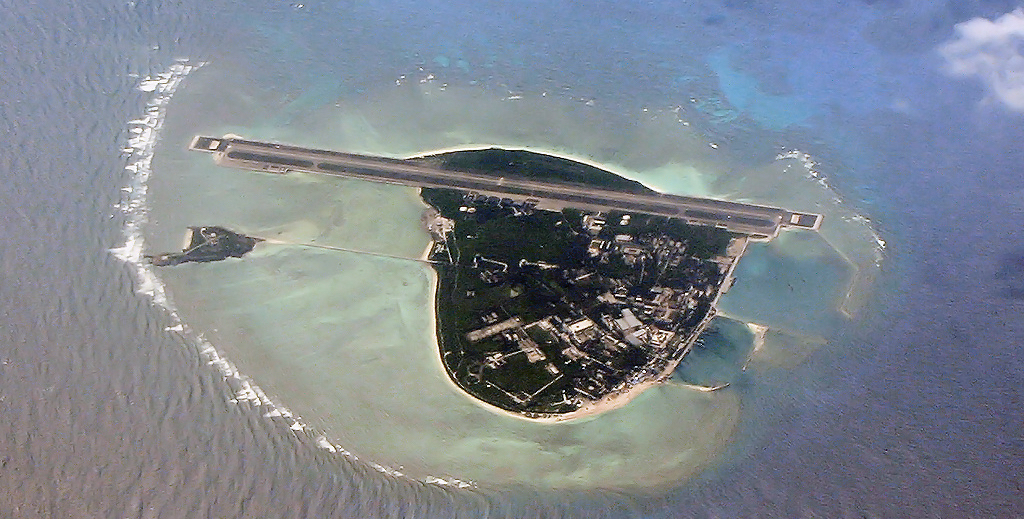Following the latest freedom of navigation exercises by the United States military in the South China Sea, under which the U.S. Navy and Air Force have regularly deployed warships and heavy bombers to sea and airspace claimed by China as its own and approached Chinese military positions in manoeuvres deemed highly provocative by Beijing, the Pentagon has issued a statement that it retains the capabilities to completely destroy Chinese bases in the region if necessary.

Following the United States’ announcement of its ‘Pivot to Asia,’ under which the country sought to rapidly increase its military presence in the Asia-Pacific region, China’s People’s Liberation Army has sought to develop a number of island outposts at strategically critical reefs and shoals such as the Scarborough Shoal and those surrounding the Spratly Island chain to better contain the military expansion of the United States and a number of its Western partners.
Construction of these defensive bases has been heavily criticised by the United States and its allies, and thought they were developed largely in response to the United States’ own pledge to increase its military presence in the region Washington and a number of Western states have accused China itself of militarising the South China Sea.
With Chinese island bases remaining relatively small, and largely artificial, built on reefs or by expanding small islets, they would if unprotected pose little challenge for the U.S. military to destroy – using its immense firepower to uproot the artificial structures.
These outposts are however increasingly heavily defended, and a U.S. assault on Chinese military facilities in the South China Sea would be among the most testing military operations carried out since the Korean War. Bases are capable of accommodating not only personnel and monitoring equipment, but also airfields which deploy advanced J-11B heavy fighters – more capable in an air superiority role than anything in the U.S. Air Force’s arsenal with the exception of the F-22 Raptor. JH-7 heavy strike fighters capable of carrying long range anti ship munitions have also been deployed.
The outposts also accommodate heavier aircraft including transports, H-6 heavy bombers and in future possibly airborne early warning aircraft such as the KJ-2000. Various subtypes of the H-6K bomber are capable of electronic warfare attacks or long range ship hunting against enemy targets, and alongside the J-11B they pose a threat to U.S. warships and aircraft in the region at long ranges.
Chinese islets are guarded by a number of cutting edge missile systems, giving them a naval and aerial anti access area (A2AD) ranges of several thousand kilometres which serve as a highly complementary asset to the combat aircraft deployed. Among these are the YJ-12 anti ship missiles, with a formidable 400km strike range, 500kg warheads, and an impact speed of up to Mach 4 – more than four times the speed of American cruise missiles as the Tomahawk.
Advanced ground based electronic warfare systems have also reportedly been deployed to Chinese outposts, and are capable of seriously disrupting the operations of hostile assets – further strengthening the islands’ defences. The island outposts are further protected by some of the most advanced long range surface to air missile systems in the world, which in an anti aircraft role are second only to the Russian S-400, the HQ-9B.
These platforms are capable of targeting hostile combat aircraft, be they fighters, bombers or support aircraft such as tankers, with 180kg warheads at ranges of up to 300km and speeds of up to Mach 4.2. The powerful radars and advanced computing power of these radar systems allows them to target stealth aircraft at intermediate ranges and intercept enemy ballistic and cruise missile attacks, and they post a serious threat to U.S. aerial assets operating offensively against Chinese installations.
Further augmenting the island outposts’ defences, assets from the Chinese mainland are capable of providing vital support and quickly reinforcing garrisons should they come under attack. Chinese land based DF-21D anti ship ballistic missiles, if deployed to Hainan, would also be able to provide lethal long range fire support.
The missiles are named ‘carrier killers’ for the lethality with which they make impact – capable of destroying vessels as large as a U.S. Nimitz or Gerald Ford Class supercarrier with a single strike. According to the U.S. Navy, American warships have no defence against such attacks. Support from these missile systems would be a game changing asset for the defence of China’s outlying island bases. Further support could come from China’s vast destroyer fleet, by far the most capable in the region, attack submarines, and even J-20 heavy stealth fighters which have recently trained for combat operations over the South China Sea – among numerous other assets.

Ultimately while United States military is well within its limits to destroy an artificial island the size of those constructed by China, conducting a successful military operation against such positions when they are defended by some of the most advanced military hardware anywhere in the world remains a different matter entirely.
Doing so would expose U.S aircraft and warships to extreme risks, and even if by applying overwhelming force such island bases were neutralised in an American attack, the losses would likely be extremely high – far beyond what would be considered acceptable for the U.S. Navy or Air Force even in times of war.
China’s military bases therefore are set to continue to expand, and further hardware including stealth attack drones and more advanced variants of existing systems such as the HQ-9C missile system and J-11D air superiority fighter will very likely be deployed as they become available. The militarised island outposts will serve their purpose as a key inhibitor of U.S. and Western military action and expansion in the region, and facilitate the growth of China’s own anti access area denial capabilities in the South China Sea.





